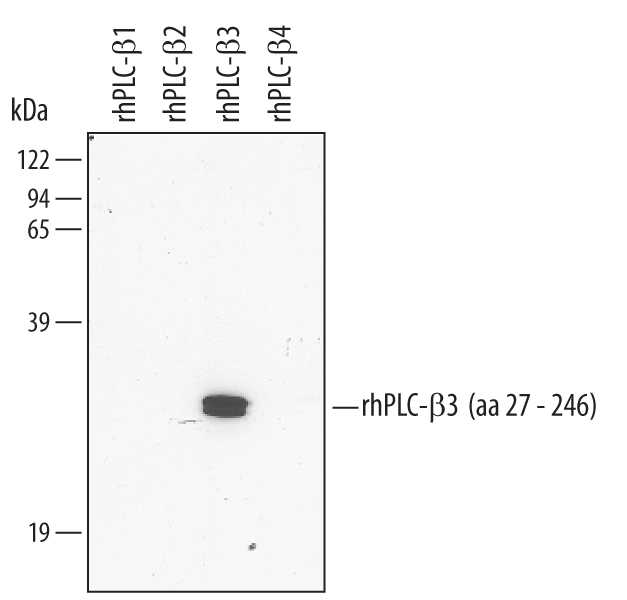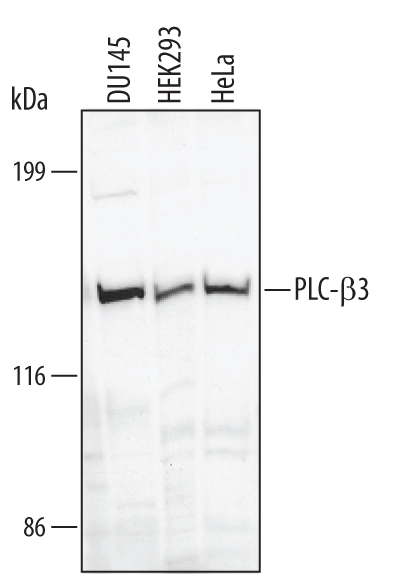Human PLC-beta 3 Antibody Summary
Applications
Please Note: Optimal dilutions should be determined by each laboratory for each application. General Protocols are available in the Technical Information section on our website.
Scientific Data
 View Larger
View Larger
Detection of Human PLC‑ beta 3 by Western Blot. Western blot shows recombinant human PLC-beta 1, PLC-beta 2, PLC-beta 3, PLC-beta 4 (5 ng/lane). PVDF mem-brane was probed with 1 µg/mL Sheep Anti-Human PLC-beta 3 Antigen Affinity-purified Polyclonal Antibody (Catalog # AF4716) followed by HRP-conjugated Anti-Sheep IgG Secondary Antibody (Catalog # HAF016). A specific band for PLC-beta 3 was detected at approx-imately 29 kDa (as indicated). This experiment was conducted under reducing conditions and using Immunoblot Buffer Group 1.
 View Larger
View Larger
Detection of Human PLC‑ beta 3 by Western Blot. Western blot shows lysates of DU145 human prostate carcinoma cell line, HEK293 human embryonic kidney cell line, and HeLa human cervical epithelial carcinoma cell line. PVDF membrane was probed with 1 µg/mL Sheep Anti-Human PLC-beta 3 Antigen Affinity-purified Polyclonal Antibody (Catalog # AF4716) followed by HRP-conjugated Anti-Sheep IgG Secondary Antibody (Catalog # HAF016). A specific band for PLC-beta 3 was detected at approximately 150 kDa (as indicated). This experiment was conducted under reducing conditions and using Immunoblot Buffer Group 1.
Reconstitution Calculator
Preparation and Storage
- 12 months from date of receipt, -20 to -70 degreesC as supplied. 1 month, 2 to 8 degreesC under sterile conditions after reconstitution. 6 months, -20 to -70 degreesC under sterile conditions after reconstitution.
Background: PLC-beta 3
The Phospholipase C family consists of 13 isozymes within six subfamilies, PLC-δ, -beta, -gamma, -epsilon, -zeta, and -eta. PLC-beta 3 (Phospholipase C beta-3) is a G-protein dependent phosphodiesterase that catalyzes the generation of inositol 1,4,5-trisphosphate (IP3) and diacylglycerol (DAG) from phosphatidylinositol 4,5-bisphosphate (IP2), an essential step in the intracellular transduction of many extracellular signals. The PLC-beta subfamily consists of 4 isozymes, beta 1-4, which differ in their tissue distribution and their ability to be activated by G proteins. PLC-beta 1 and PLC-beta 3 are more widely expressed, whereas PLC-beta 2 is resticted to hematopoietic cells and PLC-beta 4 is limited to certain neuronal cells and the retina.
Product Datasheets
Citations for Human PLC-beta 3 Antibody
R&D Systems personnel manually curate a database that contains references using R&D Systems products. The data collected includes not only links to publications in PubMed, but also provides information about sample types, species, and experimental conditions.
2
Citations: Showing 1 - 2
Filter your results:
Filter by:
-
Klotho Modulates Pro-Fibrotic Activities in Human Atrial Fibroblasts through Inhibition of Phospholipase C Signaling and Suppression of Store-Operated Calcium Entry
Authors: Y Hung, CC Chung, YC Chen, YH Kao, WS Lin, SA Chen, YJ Chen
Biomedicines, 2022-07-01;10(7):.
Species: Human
Sample Types: Cell Lysates
Applications: Western Blot -
M3 muscarinic receptor interaction with phospholipase C beta3 determines its signaling efficiency.
Authors: Kan W, Adjobo-Hermans M, Burroughs M, Faibis G, Malik S, Tall G, Smrcka A
J Biol Chem, 2014-03-04;289(16):11206-18.
Species: Human
Sample Types: Cell Lysates
Applications: Immunoprecipitation, Western Blot
FAQs
No product specific FAQs exist for this product, however you may
View all Antibody FAQsReviews for Human PLC-beta 3 Antibody
There are currently no reviews for this product. Be the first to review Human PLC-beta 3 Antibody and earn rewards!
Have you used Human PLC-beta 3 Antibody?
Submit a review and receive an Amazon gift card.
$25/€18/£15/$25CAN/¥75 Yuan/¥2500 Yen for a review with an image
$10/€7/£6/$10 CAD/¥70 Yuan/¥1110 Yen for a review without an image




